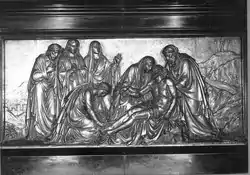Norbert van den Eynde
Norbert van den Eynde (also spelled: Norbertus van den Eynde, Norbert van den Eynden, and Norbertus van den Eynden) (Antwerp, baptized December 11, 1628 – Antwerp, October 7, 1704)[1][2] was a Flemish sculptor. He was the son of Hubert van den Eynde, a master of the Guild of Saint Luke, and a member of the Van den Eynde family of sculptors.[3][4] Van den Eynde was a close associate of Artus Quellinus II.[4] He undertook several commission for the Antwerp Cathdral, including several altarpieces.[4]
Life
Norbert van den Eynde was born in Antwerp, Spanish Netherlands, where he was baptized on December 11, 1628. Van den Eynde was born into a renowned family of sculptors, one of the top families of sculptors in Antwerp,[4] and part of the informal Quellinus-Verbrugghen-Willemsens-Scheemaeckers-Van den Eynde partnership, which had turned the sculpture market of Antwerp into one of monopoly.[4] The extensive collaboration between the workshops of these families in the late 17th century "may be the most important factor" to account for the intricate "unity of style and approaches that have made disentangling of hands particularly difficult for art historians."[4]
He was either the son of Jan I van den Eynde, and thus a nephew of Hubert (Hubrecht) van den Eynde,[4] master of the Guild of Saint Luke, or the son of Hubert (or Hubrecht) and his second wife Elizabeth van Breen.[2][1] Hubrecht's first wife Elizabeth Schorkens, by whom he might have had Sebastiaen van den Eynden (who was, at any rate, either Hubrecht's son or Hubrecht's nephew[4][3][2]), another Van den Eynde who went on to become a master of the Guild,[5] died on July 19, 1624, just a few weeks after giving birth.[2] Hubrecht later remarried to Elizabeth van Breen, who reportedly gave him Norbert in 1628.[2]
Norbert van den Eynde married twice. He first married Maria Anthonia Bagenier (who was buried on June 2, 1691 in St.-Michael's Church).[2] He later remarried to Isabella Maria Reuckelenberg/ van Beirenbergh.[2] Norbert van den Eynde was the father of Norbertus II and Cornelis (both sculptors), as well as Franchoise Theresia and Isabella Maria.[2] The latter married Jan Pauwel Gillemans the Younger on March 3, 1693, by whom she had a son before dying prematurely in October 1697.[6]
Van den Eynde and his wife lived on Arenbergstraat,[4] in the Wapper of Antwerp, where they owned at least two houses.[2] They moved to Ghent for ten months between May 1692 and March 1693, leasing their house in the Wapper to their daughter Isabella Maria.[2]
Upon their return to Antwerp, they witnessed the birth of a grandson, as well as the deaths of their daughter Isabella Maria, of her sister Franchoise Theresia, and of their brother Norbert II. Van den Eynde experienced financial trouble; had to sell his two houses on the 'Wapper', but was eventually able to pay off all his debts before his death in 1704.[2]
Van den Eynde collaborated with Artus Quellinus II on many occasions, such as for the high altarpiece of the now demolished Sint-Joriskerk; the high altarpiece of the Sint-Michielskerk of Ghent, and, between 1640 and 1670, the altar and altar garden of the fencers' guild in the Cathedral of Antwerp, completing the work commenced by Norbert's father Huibrecht.[4] Between 1683 and 1688, Van den Eynde completed an altarpiece dedicated to Saint Catherine in collaboration with Lodewijk Willemsens for the oudekleerkopers guild in the cathedral of Antwerp.[4]
In 1670, Van den Eynde and Hendrik Frans Verbrugghen were "specifically invited for their advice" to travel to Mechelen as consultants for works on the Cathedral there.[4]
Van den Eynde was a frequent supplier of marble plaques (used for ebony cabinets) for the Musson and Forchondt art dealing firms.[4]
References
- "Norbertus van den Eynden". University of Amsterdam. Retrieved August 20, 2020.
- "Norbertus van den Eynde". RKD. Retrieved August 22, 2020.
- "Eynde, van den family". Oxford Art Online. Retrieved August 20, 2020.
- "Flemish sculpture: Art and manufacture c.1600–1750" (PDF). University College London: 19, 28, 33, 50, 66, 90, 93, 185, 192, 193, 196, 199, 205, 211, 251, 252, 258, 271. 2008.
- "Sebastiaen van den Eynden". RKD. Retrieved August 22, 2020.
- Frans Jozef Peter Van den Branden, Geschiedenis der Antwerpsche schilderschool, Antwerpen, 1883, pp. 1113–1116 (in Dutch)
